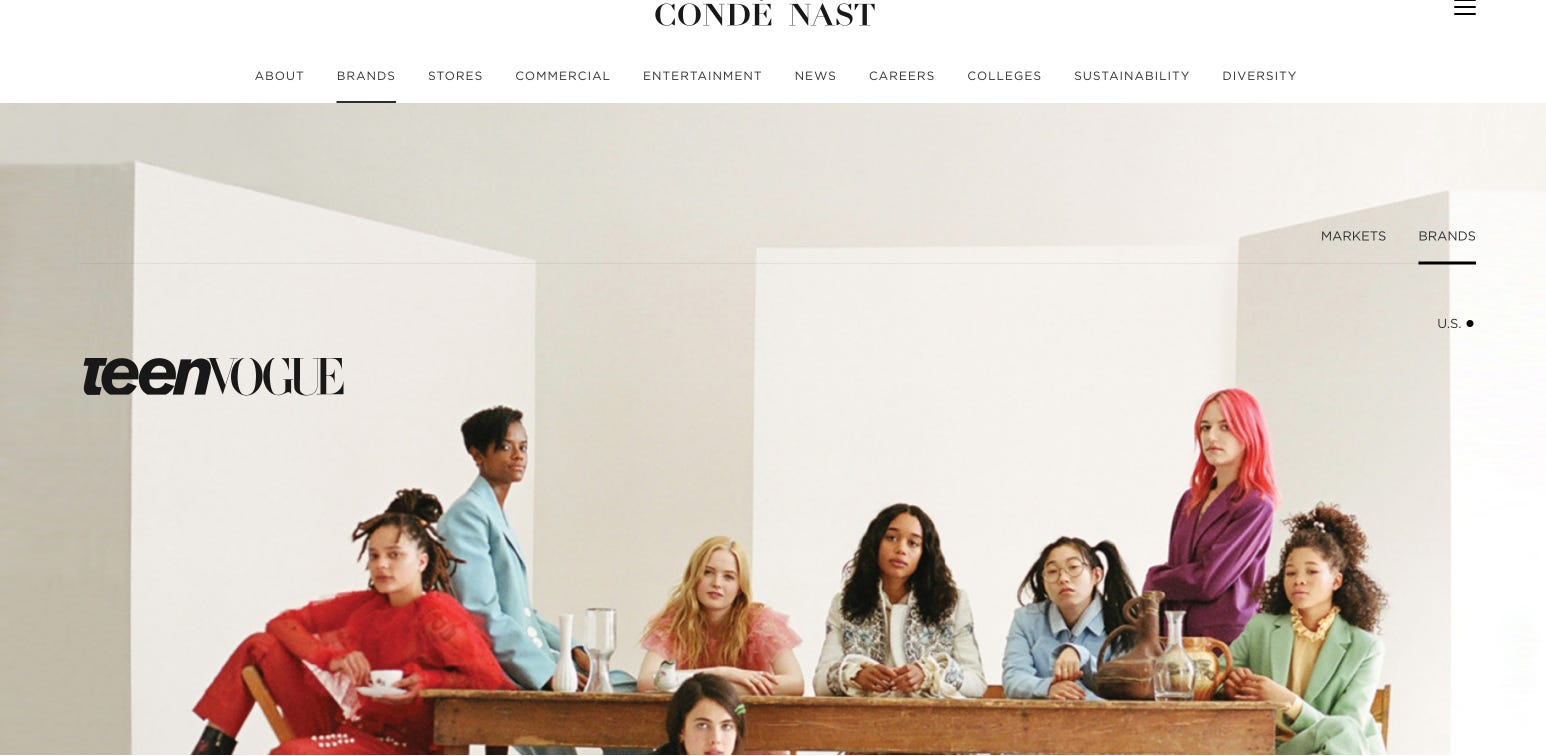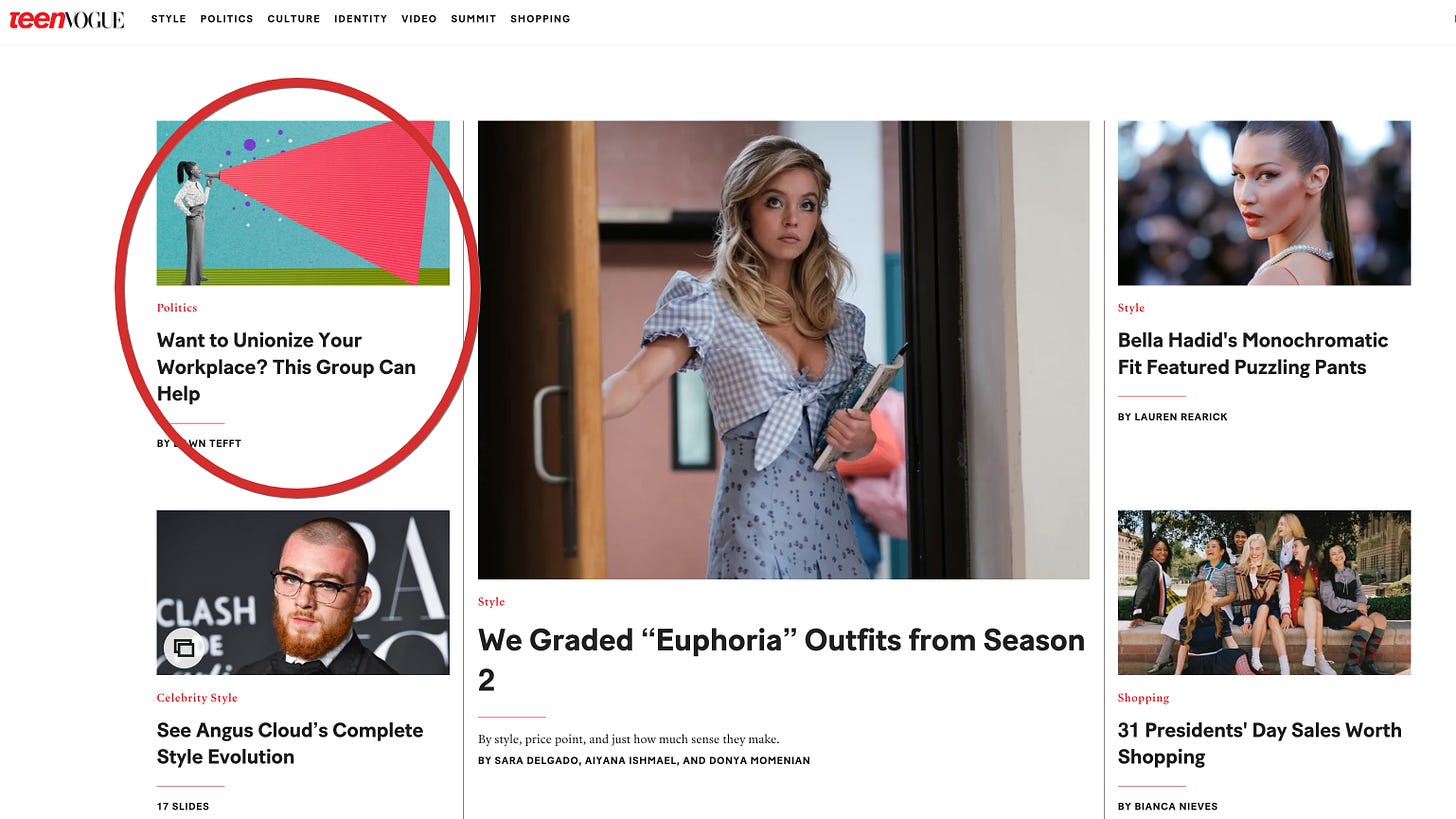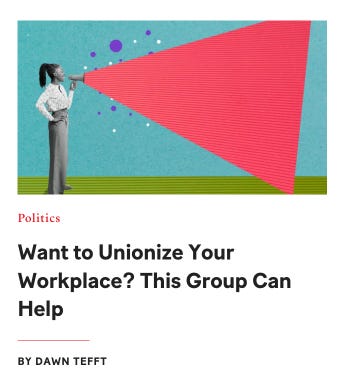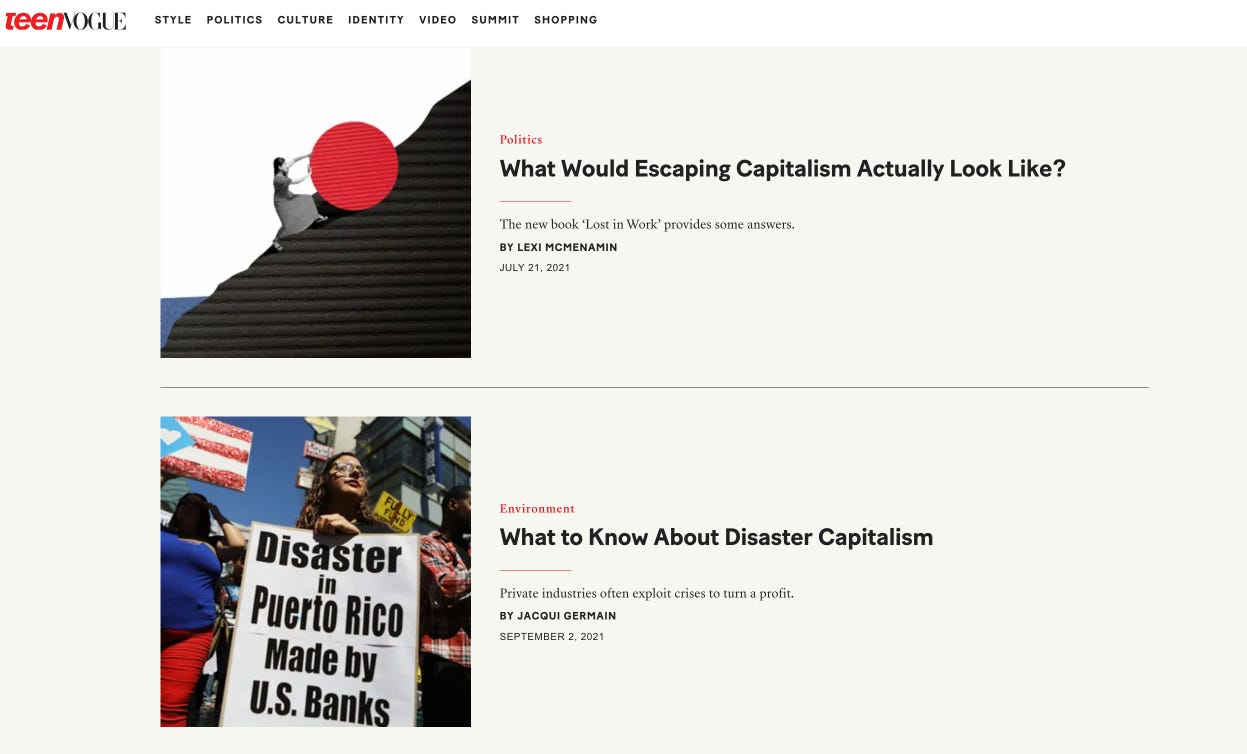Why Is Teen Vogue—A 'Fashion Magazine' For Young Women—Pushing Readers Towards Unions and Marxist Economics?
These days, indoctrination may be more the fashion at Teen Vogue.
QUICK FACTS:
Teen Vogue is a digital “fashion” magazine whose audience is 93% female with a median age of 21.
As an all-digital publication with 12 million unique users and 14 million social media followers, Teen Vogue considers itself be “the destination for the next generation of influencers.”
Over the last several years, Teen Vogue has, and continues to publish a large number of articles on the subject of unionization and socio-economics.
Nearly all those published have been slanted pro-unionization and heavily biased toward Marxian economics.
Several of Teen Vogue’s writers state on their bios that they are “organizers”—a fact that is often not included in their “articles.”
As an influencer of young people—the vast majority of them young women—the publication provides a one-sided, heavily biased view of economic issues and the workplace.
Why it matters: As America begins to “exit” from the pandemic, many companies (like Starbucks, Amazon and others) are experiencing a surge in union organizing activity and workforce militancy—driven by “Gen Z” and “Gen U” workers—and seem to be floundering to make sense of it all.
DETAILS:
Editor’s note: An email seeking comment from Teen Vogue’s Editor-in-Chief Versha Sharma has not been replied to prior publication of this post. As/if a reply is received, this post will be updated accordingly.
Condé Nast is a 113-year old global mass-media company that owns some of the world’s most well-known publications, including Vogue, The New Yorker, GQ, Glamour, Architectural Digest, Vanity Fair, Wired, and many others.
One of the many Condé Nast publications, Teen Vogue, is an all-digital* magazine aimed at young people—overwhelmingly young women.
On Condé Nast’s Teen Vogue website, it states that “Teen Vogue is the destination for the next generation of influencers. We educate, enlighten, and empower young people, arming them with all they need to lead stylish and informed lives. Teen Vogue, launched in February 2003, delivers 27 million-plus monthly impressions through a combination of TeenVogue.com, multiple social media platforms, and a robust video channel.” [Emphasis added.]

Although Teen Vogue stopped its print publication in 2018, with 12 million unique users and 14 million social media followers, one might categorize Teen Vogue as an “influencer” of young people—again, primarily young women.
‘Educate, Enlighten, and Empower’…Or Indoctrinate?
Over the last few years, Teen Vogue has published numerous articles about labor unions and socio-economics.
Nearly of them are no-so-subtly promoting labor unions and Marxian economics (i.e., progressivism or socialism), while lambasting corporations and “capitalism.”
For example, within one recent five-day period (February 17-21), Teen Vogue published two articles—both written by self-proclaimed “organizers.”
The first article, at the top of Teen Vogue’s website on February 21st appears almost like an advertisement—although it, technically, is not.
If a reader were to click on the headline “Want To Unionize Your Workplace? This Group Can Help,” it would take the reader to an op-ed entitled “Emergency Workplace Organizing Committee Is Helping Workers During COVID.”
In the very first three paragraphs of the op-ed, the reader is introduced to a problem in a hypothetical workplace…as well as the solution to the problem—an organizing committee set up by the Democratic Socialists of America and the United Electrical, Radio, and Machine Workers of America (UE)—a union once alleged to have been dominated by Communists.
You’re a grocery worker. Another COVID surge is ramping up. Hundreds of rotating customers rush in every hour without masks, and you have no plexiglass or basic protections. What do you do?
That’s where the Emergency Workplace Organizing Committee (EWOC) comes in. The project was formed jointly by the Democratic Socialists of America (DSA) and the United Electrical, Radio, and Machine Workers of America (UE) union to help non-unionized workers organize amid the life-threatening conditions of the pandemic — and beyond. Over the past two years, EWOC has helped workers across industries win through collective action in the workplace.
After a worker contacts EWOC, they are connected with a trained volunteer organizer who supports them and their coworkers in running their own campaign.
Again, the op-ed almost reads like an advertisement for the ‘Emergency Workplace Organizing Committee’ and, perhaps it should.
The op-ed writer, Dawn Tefft, is an “organizer” and is “active” Emergency Workplace Organizing Committee (EWOC), according to her bio.
Yet, a reader would have to actually click on Ms. Tefft’s bio to actually know that she is affiliated with the group she is promoting.
In another Teen Vogue article titled “Union Busting: What Are Some of the Most Common Tactics Employers Use?” (published on February 17th), the “journalist” writes about “the basic tactics and tools employers use to stop unions,” without actually acknowledging her own bias background as a “trained organizer.”
With the exception of one article (on police unions), every article reviewed that is published on Teen Vogue about labor unions is written with a decidedly pro-union bias.
Not all of the writers’ backgrounds are hidden, however.
No Class.
In another article titled “The PRO Act: What’s in It and Why Is It a Labor Movement Priority?” the writer is described as a "radical organizer” on her bio at the top of the piece.
What a casual reader might not notice in the writers’ bio is the link to the column ‘No Class,’ which features over 50 articles, many of them highlighting heroes to the hard Left—people from anarchists Emma Goldman, and Mother Jones to Jane Fonda and Dolores Huerta.
Interestingly, it is in her piece about Emma Goldman that the writer give some background to Teen Vogue’s shift toward unions and Marxist content.
Back in 2018, before I had conceived of this column or dared to hope that Teen Vogue would allow me to launch it, I asked my then editor if I could write a profile of one of labor’s most hallowed figures, an Ireland-born union organizer and fierce warrior for the working class, known to history as Mother Jones. At the time, we decided it made more sense for me to ease our readers into the wide world of labor by first breaking down what a union actually is (and why every worker needs one!). [Emphasis added.]
The ‘No Class’ column and its more-than 50 articles is not the only place Teen Vogue’s editorial bias exists.
It goes deeper: Teen Vogue’s Pro-Socialism and Anti-Capitalist bias is blatant
If one does a search of “Socialism” as well as “Capitalism” on Teen Vogues website, one can easily see the bias of the publication.
For example, in one biased 2020 article entitled “What 'Capitalism' Is and How It Affects People,” the writer (another “organizer”) explains capitalism as follows (emphasis throughout):
Capitalism is defined as an economic system in which a country’s trade, industry, and profits are controlled by private companies, instead of by the people whose time and labor powers those companies. The United States and many other nations around the world are capitalist countries, but capitalism is not the only economic system available.
Under the heading How does capitalism impact people? the writer explains:
The kind of impact that capitalism has on your life depends on whether you’re a worker or a boss….It’s all based on the principle of supply and demand, and in capitalism, consumption is king. The problem is that many capitalist bosses aren’t great at sharing the wealth, which is why one of the major critiques of capitalism is that it is a huge driver of inequality, both social and economic.
Then, in her conclusion, the writer provides a rather glowing definition socialism:
What is the difference between capitalism and socialism?
Capitalism and socialism are generally seen as polar opposites, and discussions of either system are often framed as in opposition to the other. The modern idea of socialism has roots in Greek philosopher Plato but emerged as a popular political idea in the early 19th century among German radicals like Karl Marx and Friedrich Engels. There are many forms of socialism, but at its core, socialism is an economic system in which a whole community — not just bosses or private companies — control the means of production equally. It assumes that people are naturally cooperative, instead of competitive. The goal of socialism is an egalitarian society run by democratically elected representatives for the benefit of all in accordance with a set of collectively determined parameters; unlike under capitalism, industry and production is run by the state, and the acquisition of private property is seen as counterproductive. Capitalist critics of socialism believe that the system slows economic growth, rewards worker laziness, and can stifle individual rights and free expression.
In a capitalist country, the focus is on profits over anything else; in a socialist country, the public is seen to be more important, and social welfare is a major priority. The United States, the U.K., and Germany are examples of modern capitalist countries. Many other countries like Norway, Sweden, Canada, and the Netherlands incorporate socialist ideas into their societies, as does the U.S. to some degree; for example, universal health care and Social Security are both socialistic concepts.
While her definition may not be wholly inaccurate, her indictment of capitalism as a “a huge driver of inequality, both social and economic” and the United States (which produces more wealth for more people than any country in the world) while promoting socialism in mostly glowing terms is but one example of the skewed economic bias of Teen Vogue’s writers.
Influencing the Influencers…To what end?
In article after article reviewed, many written by the same writers, the pro-union, pro-Marxism bias of Teen Vogue is very apparent. There does not appear any balance in its content. Why?
To answer why Teen Vogue—a fashion magazine whose readers are overwhelming young women—is so biased, one need only to return to the Condé Nast’s description: “Teen Vogue is the destination for the next generation of influencers. We educate, enlighten, and empower young people, arming them with all they need to lead stylish and informed lives.”
Condé Nast appears to have made a conscious decision to influence the “influencers” and if one of the definitions of ‘influence’ is “the capacity or power of persons or things to be a compelling force on or produce effects on the actions, behavior, opinions, etc., of others,” what ‘effects’ is Teen Vogue trying to affect?
In other words, to what end?








